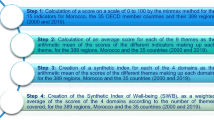Abstract
This study investigates the convergence of well-being between Sub Saharan Africa (SSA) and Organization for Economic Cooperation and Development (OECD) member countries during the period 1980–2014. The gap in living standard was examined from a steady state represented by the average income of OECD countries. Applying the unit root estimation technique to test for convergence with and without structural breaks, the result shows that; among a total of 43 countries studied, about 14 % are converging towards the average of OECD average. When the shock caused by the economic crisis of 2008 was factored into the analysis, the gains of about five countries out of the six converging disappeared. These results are disturbing owing to the fact that countries in the Asian region that started almost at the same level with SSA have converged to form a convergence club. Therefore, a lot more effort is needed from the government and stake holders in most countries in SSA to improve on the determinants of growth like good health care, quality institutions, better education and commitments to pursue developmental programmes which will boost the income of an average African to acquire better life.

Similar content being viewed by others
Notes
African Economic Outlook 2011 report (AEO) presents details about the poverty situation in SSA.
References
Barro, R. (1991). Economic growth in a cross section of countries. Quarterly Journal of Economics, 106(2), 407–443.
Barro, R., & Sala-i-Martin, X. (1991). Convergence across states and regions. Brookings Papers of Economic Activity, 1, 107–182.
Barro, R., & Sala-i-Martin, X. (1992). Convergence. Journal of Political Economy, 100(2), 223–251.
Baumol, W. J. (1986). Productivity growth, covergence, & welfare: What the long run date show. American Economic Review, 76(5), 1072–1085.
Bernard, A. B., & Durlauf, S. N. (1991). Convergence in international output movements. National Bureau of Economic Research Working Paper no. 3717.
Bernard, A., & Durlauf, S. (1995). Interpreting tests of the convergence hypothesis (Vol. 159). New York: National Bureau of Economic Research.
Cho, D., & Graham, S. (1996). The other side of conditional convergence. Economics Letters, 50, 285–290.
Clark, R. (2012). World health inequality: Convergence, divergence, and development. Social Science & Medicine (1982), 72(4), 617–624. doi:10.1016/j.socscimed.2010.12.008.
Habibullah, M.S., Dayang, A.A.M., Liew, V.K.S., & Lim, K.P. (2008). Testing nonlinear convergence in Malaysia, 1965–2003. MPRA, Paper No. 12110.
Hobijn, B., & Franses, P. H. (2001). Are living standards converging? Structural Change and Economic Dynamics, 12(2), 171–200. doi:10.1016/S0954-349X(00)00034-5.
Kalbasi, N. (2010). Economic growth convergence among Middle East countries. Journal of Economics and International Finance, 2(10), 231–236.
Kuznets, S. (1955). Economic growth and income inequality. American Economic Review, 45(1), 1–28.
Liew, V.K.S. & Yusof, A. (2006). Income convergence? Evidence of non linearity in the East Asian economies: A comment. MPRA, Paper No. 519.
Maddison, A. (2003). The world economy: A millennial perspective. Paris: Development Center for the OECD.
Mcmichael, A. J., Mckee, M., Shkolnikov, V., & Valkonen, T. (2004). Mortality trends and setbacks: Global convergence or divergence? The Lancet, 363(9415), 1155–1159.
Milanovic, B. (2006). Economic integration and income convergence: Not such a strong link? The Review of Economics and Statistic, 88(4), 659–670.
Nahar, S., & Inder, B. (2002). Testing convergence in economic growth for OECD countries. Applied Economics, 34(16), 2011–2022. doi:10.1080/0003684011011783.
Neumayer, E. (2003). Beyond income: Convergence in living standards, big time. Structural Change and Economic Dynamics, 14(3), 275–296. doi:10.1016/S0954-349X(02)00047-4.
Neumayer, E. (2004). Does the “resource curse” hold for growth in genuine income as well? World Development, 32(10), 1627–1640. doi:10.1016/j.worlddev.2004.05.005.
Pesaran, M. H. (2007). A pair-wise approach to testing for output and growth convergence. Journal of Econometrics, 138(1), 312–355. doi:10.1016/j.jeconom.2006.05.024.
Quah, D. T. (1993). Galton’s fallacy and tests of the convergence hypothesis. Scandinavian Journal of Economics, 95, 427–443.
Quah, D. T. (1996). Empirics for economic growth and convergence. European Economic Review, 40(6), 1353–1375.
Rassekh, F., Panik, M. J., & Kolluri, B. R. (2002). A test of the convergence hypothesis. International review of Economics and Finance, 10(2), 147–157.
Rostow, W. (1960). The stages of economic growth: A non-communist manifesto. Cambridge: Cambridge University Press.
Sala-i-Martin, X. (1996). Regional cohesion: Evidence and theories of regional growth and convergence. European Economic Review, 40(6), 1325–1352.
Solow, Robert M. (1956). Contribution to the theory of economic growth. Quarterly Journal of Economics, 70(1), 65–94.
The World Bank, World Development Indicators [Data file]. (2014). http://databank.worldbank.org/data/reports.aspx?source=world-development-indicators.
The World Bank, World Development Indicators. (2015). Poverty and equity databank. Retrieved from http://povertydata.worldbank.org/poverty/region/SSA.
The United Nations News Centre. (2006). Life expectancy in sub-Saharan Africa is lower than 30 years ago: UN index. http://www.un.org/apps/news/story.asp?NewsID=20548.
Villaverde, J., & Maza, A. (2011). Globalization, growth and convergence. The World Economy, 24(6), 952–971.
Welsch, H., & Bonn, U. (2008). Economic convergence and life satisfaction in the European Union. The Journal of Socio-Economics, 37(3), 1153–1167. doi:10.1016/j.socec.2006.12.072.
White, A. (2007). A global projection of subjective well-being: A challenge to positive psychology. Psychtalk, 56, 17–20.
Yau, R., & Hueng, C. J. (2007). Output convergence revisited: New time series results on industrialized countries. Applied Economics Letters, 14(1), 75–77. doi:10.1080/13504850500425543.
Zivot, E., & Andrews, W. K. (1992). Futher evidence on the great crash, the oil-price shock, and the unit-root hypothesis. Journal of Busines and Economic Statistics, 10(3), P811.
Acknowledgments
We acknowledge the anonymous reviewers for their valuable comments, suggestions and contributions. We also thank our institutions for providing us the platform to conduct and accomplish this study.
Author information
Authors and Affiliations
Corresponding author
Ethics declarations
Compliance with ethical standards
All journals used for this study are cited appropriately and the data used for this study are obtained from the World Development Indicators of the World Bank.
Conflict of interest
None.
Rights and permissions
About this article
Cite this article
Adamu, P., Kaliappan, S.R., Sirag, A. et al. Can well-being between Sub-Saharan Africa (SSA) and Organization for Economic Cooperation and Development (OECD) member countries converge?. GeoJournal 82, 369–377 (2017). https://doi.org/10.1007/s10708-015-9687-6
Published:
Issue Date:
DOI: https://doi.org/10.1007/s10708-015-9687-6




